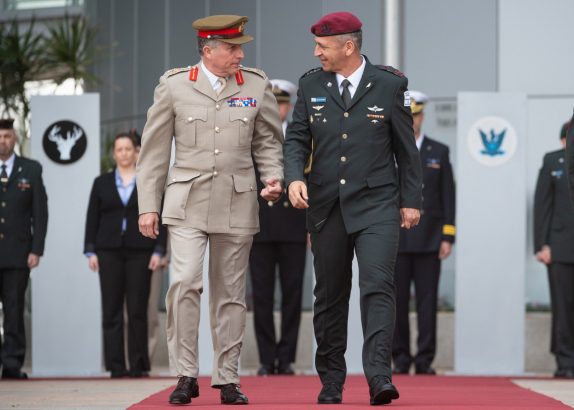Technology is radically transforming the battlefield, revolutionising doctrines of warfighting and counter-terrorism. ‘Hybrid warfare’ is the new reality. These changes are bringing the UK and Israeli militaries closer together, a development crowned by the Israel-UK military cooperation agreement signed in December 2020. Seth Frantzman, author of the forthcoming Drone Wars: Pioneers, Killing Machines, Artificial Intelligence, and the Battle for the Future (Permuted Press, July 2021), reports on this deepening partnership.
In mid-January, Elbit Systems – one of Israel’s three major defense companies, along with Rafael Advanced Defense Systems and Israel Aerospace Industries – announced that its UK subsidiary had received a $166 million contract for the Royal Navy’s Future Naval Training Program. It was only the latest example of deepening cooperation between the Israel and UK militaries in the face of new threats, new technologies, and new war-fighting strategies.
What Israel Offers: technological innovation married to real-world experience
Increasingly, Israel is a key partner for the UK on defense technology while Israel’s experience over the last several years in confronting complex adversaries on the changing modern battlefield is informing militaries from London to New Delhi. Israel and the UK signed an agreement on military cooperation in December 2020. At the heart of what makes Israel unique, compared to other British partners and allies, is that Israel’s hi-tech military has a plethora of real-world experience dealing with the latest threats. These threats include Iranian-made drones, such as the one that penetrated Israeli airspace in February 2018, and Iran’s extensive missile program that has transferred technology to militants in Gaza, Lebanon, Syria and Iraq.
Israel’s defence exports reached $7.2 billion in 2019 and Israel’s defence industry is one of the largest in the world. Israel is also undergoing rapid changes in its defence doctrine and how it envisions the future battlefield. To understand those changes I’ve spent part of the last year, while observing Covid-19 restrictions, visiting with Israeli defence technology leaders and observing Israeli military drills. For instance, as Israel’s summer turned to autumn, I went to see how Israel’s Golani infantry and 7th Armored Bridge conduct a joint exercise on the Golan Heights. In the rolling hills that form a steppe beneath Mount Hermon, and spread out towards the plains around Damascus, Israeli Merkava IV tanks pounded an area in the distance with shells. Then they advanced with infantry through a mock village. It was the culmination of days of drilling that take place during the day and night.
For Israel, the name of the game today is combining units and doing ‘multi-dimensional’ exercises. This concept is difficult to grasp but at its essence is leveraging Israeli advances in technology to dominate enemies using every means possible on the battlefield. For instance, that means a more digitised approach to soldiering. Historically infantry soldiers have gone into battle with basically the same kinds of technology, the rifle and the boot, that they had generations ago. While air power has been transformed and navies are changing, things like tanks and infantry appear the same. However the modern battlefield has a plethora of new sensors on it, from small drones, to optics that enable a commander to receive a lot more real-time data. The challenge on a battlefield therefore may not just be locating an enemy but quickly deciding how to neutralise the adversary. That means using more precise weapons and allowing technology to assist soldiers more.
As part of this revolution in warfighting Israel rolled out a new multi-year plan in 2020 called Momentum. The plan is supposed to mean using more special forces and combined units, along with increasing the connections between units to bring intelligence quickly to frontline forces. It also combines Israel’s multi-layered air defence systems with the latest F-35 warplanes. Israel’s Defence Minister Benny Gantz said in January 2021 that he is open to buying more F-35s. Israel also took delivery of the new German-built Sa’ar 6 ship. The corvette will be packed with more firepower and systems than any ship in Israel’s navy and will protect Israel’s economic zone off the coast. ‘The mission of defending Israel’s exclusive economic zone and strategic assets at sea is the primary security mission of the Israeli Navy. These assets are essential to the operational continuity of the State of Israel, and having the ability to protect them holds critical importance,’ said the commander of the Israeli Navy, Maj. Gen. Eli Sharvit, introducing the Sa’ar 6 last year.
Ramifications for the UK
What this all means for Israel and the United Kingdom is that Israel’s technology has ramifications for the future of the British armed forces. In October, British soldiers got a look at some Israeli technology during the UK’S Army Warfighting Experiment. Elbit Systems sent its Rhino mobile headquarters to the UK so field commanders could see what the future digital armed forces headquarters could look like.
There have been great advances since commanders in the Second World War used caravans as a kind of traveling headquarters and home in the field. Field Marshal Bernard Mongomery used several mobile caravans, now at the Imperial War Museum Duxford, during his period at the front. One was an office, another a map room, and another for sleeping. Much has changed today. With the British army seeking to be more agile with command, control and communication, the ‘3 Cs’ or C3 part of warfare, a new mobile ‘digital backbone’ by Elbit could help. Think of climbing into a militarised, rugged, caravan, stepping up from the dust of the battlefield, into a confined space festooned with computers. You have left behind the war that looks like the 20th century and entered the world that is more a reminder of Star Wars, Robocop or Terminator. The future battlefield is all about sponging up information, processing it with algorithms and artificial intelligence, and helping commanders decide what to do next.
Elbit calls its system the ‘Rhino protected command and control center.’ It uses a variety of Elbit technology such as a battle management system and software defined radios. These radios have been supplied by Elbit to Spain, Switzerland and other countries. Secretary of State for Defence Ben Wallace saw the Elbit display in October. ‘The Army Warfighting Experiment is a valuable opportunity for collaboration between industry and the military community. This year, Elbit Systems UK was able to take part in wide-ranging discussions and demonstrations, combining our pioneering technology, with the expertise and proficiency of UK Armed Forces personnel,’ said Martin Fausset, CEO of Elbit Systems UK. ‘Working in this way together we can propel the development of UK defence capabilities, helping the British Army to effectively utilise developments in C4I technology, and to experiment with open and agile Command, Control and Communication systems.’
The new year brings new possibilities. The recent deal for the Royal Navy includes a Future Submarine School in which ‘Elbit Systems UK will develop and deliver a new Combat Systems Operator Trainer in the Future Submarine School and modernise and manage legacy synthetic training systems across the Royal Navy.’ Fausset praised the program as a pathfinder for the Navy’s transformation. ‘We are proud to be a part of the team to deliver next-generation training capabilities to the Royal Navy, following on the success of the Company’s provision of advanced training capabilities to the British Army and the Royal Air Force.’ Today Elbit employs 500 people at ten sites in the UK. It has played a key role in the Watchkeeper UAV program for the army and is providing the MORPHEUS Battlefield Management Application for the British Army.
Entwined History, Deepening Cooperation
Israel’s close connection to British military developments is natural, considering the long entwined history the countries share. Many of Israel’s first Chiefs of Staff of the IDF gained experience under British officers such as Orde Wingate during the British Mandate. Others, such as Haim Laskov served in the British army with the Jewish Brigade. Jewish volunteers also trained as parachutists with the British, eventually jumping into eastern Europe to work with the partisans in places like Yugoslavia. Israeli President Chaim Herzog was commissioned as an officer at Sandhurst.
In later years the influence that the British army had on Israel has shifted such that the UK has studied Israeli military operations for years. Col. Richard Kemp, a former commander of British forces in Afghanistan, recalled in 2013 that the ‘British army as a whole made a considerable study of the IDF.’ He considered study of Israel’s operations, ‘above all contemporary forces,’ a key part of what British officers learned.
Today, the UK partner in cyber security and other layers of defence technology. UK Ambassador to Israel Neil Wigan said he was delighted to announce that the UK and Israeli Chiefs of Staff signed an for military cooperation. The agreement will formalise and enhance the close relationship between Jerusalem and London. Israel’s Chief of Staff Aviv Kochavi signed the agreement virtually with the UK’s Chief of the Defence Staff General Sir Nick Carter.
Carter’s close relationship with Israel was cemented during an April 2019 visit, prior to the Covid crisis that has made in-person meetings near impossible. He touched down for a visit with Kochavi at the IDF’s Kirya military headquarters in Tel Aviv. He also met commanders of the 91st Division in Israel’s north. During his trip he honoured the Jewish parachutists who had jumped into Nazi-occupied eastern Europe during the Second World War. Israel had built on that legacy with joint air force training in 2019 during the Cobra Warrior exercise.
Carter’s visit included meetings with Israel Major General Tamir Heyman of the Military Intelligence Directorate. He also took part in a ceremony at Ramat David Air Base that was supposed to mark the increasing partnership with Israel. The event was called Generation Arrow and was a brainchild of the IDF’s International Cooperation Unit. It is supposed to represent historic cooperation between the IDF and other militaries. The UK’s military, because it played such a key role in the formation of units that became the IDF, is naturally one of the oldest military connections that Israel’s IDF has.
Israel’s close military relationship with the UK and arms sales, have not been without their controversy. In recent years, articles critical of the relationship have appeared in press in the UK, Turkey and other countries, fueling protests in England against military arms sales to Israel. Jeremy Corbyn, the former Labour leader, called for a review of sales to Israel and Turkey’s pro-government Anadolu claimed arms sold from the UK were used by Israel to confront protests in Gaza. Hashtags attacking Elbit were posted online and there were calls to end the sales. The outrage led to a number of articles in 2018 and 2019, a chorus that appears to have died down after. The claim that close military relations enable Israeli human rights abuses continue.
Arms sales are reportedly at a record high in the last years. Israel has become the UK’s eight largest arms market. Sales from the UK to Israel include, according to The Guardian, items for targeting ‘small arms ammunition, missiles, weapon sights and sniper rifles. In 2016 the UK issued licenses for anti-armour ammunition, gun mountings, components for air-to-air missiles, targeting equipment, components for assault rifles, components for grenade-launchers and anti-riot shields.’ In contrast Israel’s sales to the UK are more on the hi-tech end of defence technology.
Besides the UAVs, future naval program, the digital command center, and radios, Elbit has also been awarded a $38 million contract by the UK Ministry of Defence to supply comprehensive joint fires simulation training artillery systems to the British Army. These are usually multi-year programs. This kind of innovation illustrates what Israel is best at when it comes to the modern battlefield: Technology. This means Israel’s real contribution to the modern battlefield is not about bullets or tank treads, but the most complex innovations related to surveillance, precision targeting, electro-optics and communication.
Why Israel Leads
How Israel became a leader in defence technology is a long and complex story. Several decades ago Israel’s military was transitioning from the conventional wars it had waged against Egypt and Syria, and in Lebanon in 1982, to an army conducting counter-insurgency. This required new methods and intelligence to find and neutralise terrorists. However those policies, shaped by the Oslo Accords and withdrawal from Lebanon in May 2000, led to an army that was doing more police operations against rioters than it was doing major exercises. The Second Intifada and Operation Defensive Shield further pushed Israel to conduct counter-insurgency operations of the kind the US would be doing in Iraq after 2003.
Israel was shocked in 2006 when its army did not perform as well as it thought it would against Hezbollah in Lebanon. Rocket fire from Lebanon continued despite an air force campaign designed to crush Hezbollah and Israeli divisions that were sent into Lebanon reported that they had trouble communicating with neighbouring units and waging war effectively. Major reforms were enacted to change the culture of the IDF, changes that paid off in 2008 and 2009 during Operation Cast Lead in Gaza. A review of the changes noted that the Israeli ground forces had ‘undergone a major cultural change in terms of decisiveness, aggressiveness, commitment to the mission and willingness to accept casualties.’
The IDF increased training after 2006 and changed its doctrine, tossing out a confusing doctrine that soldiers had disliked in 2006, for a kind of ‘back to basics’ approach to conventional war. Israel’s warfighting has gone through a revolution in the last ten years since the operations in Gaza in 2009 and 2014. First of all, Israel built and successfully used the Iron Dome air defence system. Designed to stop unguided rocket fire from Gaza, the system now has increased its abilities to stop drones and other types of munitions. Israel has ramped up its other air defence layers, the David’s Sling and Arrow systems. Together they create an integrated forest of missiles that are designed to stop everything from massive Iranian ballistic missiles, to mortars. They can also hunt down small manoeuvring drones and cruise missiles, of the kind Iran used against Saudi Arabia in 2019.
This is important because air defence is changing how Israel wages war. Ten years ago Iron Dome had its first success. Since then it the system has downed thousands of rockets from Gaza and had a success rate beyond 90 per cent. Israeli radar systems, from Elta, also help identify the incoming munitions. This is key because detecting the threat is what helps guide the air defence system. Saudi Arabia never detected the Iranian cruise missile and drone attack in September, until after the weapons began impacting the Abqaiq facility. Israel has created a massive shield around the country to stop all manner of weapons. This has provided Israel the ability to hold-off on military operations as well. For instance in 2018 and 2019 when some 1,500 projectiles were fired from Gaza, Israel could wait and not launch a ground invasion. That means fewer casualties on both sides. Israel sought to use the breathing space from not fighting in Gaza to focus on Iran and threats from Iranian proxies in Syria and Lebanon. Since 2014, Israel has launched more than 1,000 airstrikes against Iranian elements in Syria.
The ramifications of all this for the UK are important because Israel’s changing doctrine has helped inform modern hi-tech western militaries. Israel’s successes and failures against terrorism have also informed militaries in the West. Where Israel has succeeded is in precision munitions, reducing casualties and improving defence systems. Besides Iron Dome, Israel’s Rafael Advanced Defense Systems also built the Trophy defense system for tanks. This has been sold to the US army and is now coating US tanks. Rafael also delivered two Iron Dome batteries to the US as the Americans consider how they might learn from Israel’s experience with short and medium range air defence. The US has also invested in this air defence, working with Israel on joint programs like Arrow and David’s Sling. This is a major change from the Gulf War thirty years ago when Israel needed the US Patriot system for defence against Saddam Hussein’s Scud missiles.
If there is a symbol of how Israel has changed it is that it has gone from a country seeking defence technology to an innovator supplying the technology around the world. In February Israeli companies will take part in Abu Dhabi’s IDEX defence confab for the first time, participation made possible by the Abraham Accords. The UK will likely be taking note of the kinds of technology on display as Israeli and British military personnel continue their legacy of close military cooperation.




































